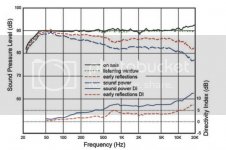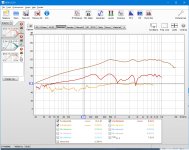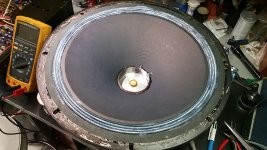It has, it just gets ignored. Doppler distortion in driver is not really an issue. It can be, of course, in a poor design, but it needn't be. And almost any nonlinear distortion in the driver itself needn't be an issue, so design it out. That's why you don't hear much about it because most professionals have moved on to topics of significance. Nonlinear distortion in drivers is not an issue. Again, Floyd Toole and I are complete agreement on this point - it's been laid to rest.
How do you recommend I measure/monitor this non linear distortion? or a benchmark, status quo specs in this area?
I recommend you move on to other issues that are more significant - like directivity control.
There is no measure of nonlinear distortion that correlates to perception, so there are no meaningful "benchmarks" or "specs."
There is no measure of nonlinear distortion that correlates to perception, so there are no meaningful "benchmarks" or "specs."
OK, so literally keep this thing under XMAX and skies the limit. Here I am leaning over the AXi hornless listening for IMD and doppler.... This is soooo interesting to me! Aaaaagh. I took the Axi's out of the box like 3 weeks ago and look where we are now.
I do agree that in either case smooth and nearly flat DI is essential..
This is a spinorama for the JBL M2 that I'm sure you are familiar with. It's DI does not looks flat, it rises but is relatively smooth. Is it a bad speaker ??
Attachments
The advertising obviously has nothing to do with practical reality 🙄
The values should be doubled, the 2370a can be used from about 800 Hz and the PHRN1014 from 1000 Hz.
I would agree with that.
I can hammer the responses flat and phase correct (FIR) them to get the two nearly the same for comparisons. They still sound a bit different though. A bit surprised by that.
I don't think I found xmax yet and I can't play any louder at the moment...this is still measured about 1.5" from exit
Attachments
Last edited:
This is a spinorama for the JBL M2 that I'm sure you are familiar with. It's DI does not looks flat, it rises but is relatively smooth. Is it a bad speaker ??
That's a respectable DI when compared to many other speakers. Is it perfect or ideal, no, but it's not bad. I'd look to fix the beaming at the high end with a better waveguide.
To me, in the spinorma data the vertical is given too much weight, i.e. equal. I do not consider the vertical DI to be as important as the horizontal because we live in the horizontal, not the vertical.
In my room designs the vertical is dealt with in the room differently than the horizontal minimizing the vertical DI and maximizing the horizontal. Spatial aspects of sound are stickily horizontal (our ears) and vertical only acts to interfere.
Last edited:
Camplo,I can't blame anyone but myself but how did I miss that this damn thing can play loud enough inside a house that it doesn't even need a damn horn to play 20,000-200hz even? 😡😡😡 ( I think Gedlee hinted at it)
Some where for this there is a line between fidelity and extension...the deeper its played, in particular without loading, the more excursion, so since it has enough XMAX to play to 200hz without a horn doesn't mean it should...How do I draw the line on excursion for modelling purposes?
I am so mad at myself yet happy...so the Axi.....or even other large format compression drivers can be viewed as a 4" fullrange driver (or in my case 5-1/4?) with limited Xmax.....not only that but the uiltimate 4" fullrange driver in the terms of HF performance....in the domestic environment...which includes studio.
You appear to be using Xmax interchangably with Xlim/Xmech in reference to a high frequency driver. Xmax is linear excursion, while Xlim is the limit of the suspension without damage.
In the case of a HF compression driver, the excursion is limited by diaphragm contact with the phase plug, which will unmistakably sound bad, like shaking coins in a plastic mug.
The HF compression driver's Xlim is no more than Xmax.
The annular ring Axi diaphragm has a larger voice coil than a 4" diaphragm, but about the same Sd.
Assuming 1mm Xlim (generous, it's probably less) your Axi driver with no horn could produce around 95dB at 200Hz at one meter, while a 4" fullrange driver (at only 2mm excursion) could do another clean 6 dB more, an easy 101 dB.
The full-range driver would not sound "broken" hitting peaks of 106+dB, while the Axi would have you cringing every time 95 dB at 200 Hz is reached.
A 15" driver at 2mm excursion can produce around 124dB at one meter, "sounding" about 5 times as loud as the Axi with no horn.
At that level, most listeners would find a 200Hz sine wave tone "uncomfortably loud" 😉
Art
Attachments
I don't think I found xmax yet and I can't play any louder at the moment...this is still measured about 1.5" from exit
Thx for that.
So that's CD only, no horn, at about 1.5", am i correct ?
SPL correct/calibrated?
My remembrance is you have the 464 horn, can you post same graphs with horn on ?
At mouth, a bit out from mouth, wherever, just give mic location....with calibrated SPL..
Many thanks...keen interest in both driver and horn...
That chunky stuff on the 2nd harmonic by 60hz...2nd harmonic starts peaking there...maybe thats xlim? Maybe thats xmax in the peaks around 350hz?
The measurements from the pic above
The measurements from the pic above
Even at low volume? at 20hz? I don't mean to question you but I have no idea....unmistakably sound bad, like shaking coins in a plastic mug.
Thx for that.
So that's CD only, no horn, at about 1.5", am i correct ?
SPL correct/calibrated?
My remembrance is you have the 464 horn, can you post same graphs with horn on ?
At mouth, a bit out from mouth, wherever, just give mic location....with calibrated SPL..
Many thanks...keen interest in both driver and horn...
the very last measurement is at 1.5, the previous 2 at the exit...
Its a minidsp usb umik-1....how do you calibrate it?
I have a 350hz eliptical tractrix a 2380a and a 2386...but I've only played with the e-tractrix so far....
click here
this is at the mouth with no XO...
Last edited:
I'm not seeing your picture, but hammering the diaphragm will result in non-harmonically related distortion/noise.That chunky stuff on the 2nd harmonic by 60hz...2nd harmonic starts peaking there...maybe thats xlim? Maybe thats xmax in the peaks around 350hz?
Even at low volume? at 20hz? I don't mean to question you but I have no idea....
At 20 Hz, the Axi probably can do around 55 dB at 1 meter, about 20 dB less than you are likely to hear, you would hear the hammering noise more than the fundamental tone.
At 40Hz, it should do around 67 dB at 1 meter, in a quiet room you may just hear the tone before the noise. There will be a level where you hear the 40Hz tone, (likely with high levels of HD), then a rapid change to a "buzzy" or "clacky" sound.
3 quotes:
"At best, Intermodulation Distortion leads to dull, veiled, or lifeless-sounding music. At worst, everything sounds harsh and/or grossly distorted."
"Intermodulation (IM) or intermodulation distortion (IMD) is the amplitude modulation of signals containing two or more different frequencies, caused by nonlinearities or time variance in a system. ... IMD is only distinct from harmonic distortion in that the stimulus signal is different."
"The most important type of distortion in loudspeakers is modulation."
Especially for a 2 way without separate subs, IMD is worth, or mandatory paying attention to.
There are at least 3 reasons why many folks cherish the midrange of the Altec 416-8B, as well as the adequate low freq. capabilities in an appropriate sized (very large) cab.:
1. Low Xmax, less than 4 mm
2. Low Mms, 51.6 Grams
3. Curvilinear cone and a small VC diameter (see attachment).
"At best, Intermodulation Distortion leads to dull, veiled, or lifeless-sounding music. At worst, everything sounds harsh and/or grossly distorted."
"Intermodulation (IM) or intermodulation distortion (IMD) is the amplitude modulation of signals containing two or more different frequencies, caused by nonlinearities or time variance in a system. ... IMD is only distinct from harmonic distortion in that the stimulus signal is different."
"The most important type of distortion in loudspeakers is modulation."
Especially for a 2 way without separate subs, IMD is worth, or mandatory paying attention to.
There are at least 3 reasons why many folks cherish the midrange of the Altec 416-8B, as well as the adequate low freq. capabilities in an appropriate sized (very large) cab.:
1. Low Xmax, less than 4 mm
2. Low Mms, 51.6 Grams
3. Curvilinear cone and a small VC diameter (see attachment).
Attachments
The first quote is false, because there are levels below which NL distortion is not audible. And this is higher than most people understand.
The last is false for two reasons 1) it is well known that FR is the most audible distortion parameter and 2) as NL distortion, it is true only to the extent that it is the largest, but still not audible.
The second is just the definition.
The last is false for two reasons 1) it is well known that FR is the most audible distortion parameter and 2) as NL distortion, it is true only to the extent that it is the largest, but still not audible.
The second is just the definition.
Is the Jbl m2, being so highly rated and as well, crossed over at 800hz, on its 15" (34hz f3 I think), conformation of this?>
And then are people confusing one issue for another?
And then are people confusing one issue for another?
Last edited:
I think the M2 has a 1.5" throat, if it does the rise from 10 to 20K is hard to avoid without using a 1" throat, which you have spoken about before. Given camplo is using a 2" exit driver the top end will beam on most waveguides.That's a respectable DI when compared to many other speakers. Is it perfect or ideal, no, but it's not bad. I'd look to fix the beaming at the high end with a better waveguide.
The M2 at 800Hz is being crossed outside the CD's comfort zone as has been spoken about elsewhere (the distortion rises in that region) but it was done to have a smoother directivity match between the 15" and waveguide, so directivity was prioritized over distortion.Is the Jbl m2, being so highly rated and as well, crossed over at 800hz, on its 15", conformation of this?>
And then are people confusing one issue for another?
I was speaking on IMD and the woofer handling midrange...this is where there would be a doppler affect from playing low notes at volume, according to some...but is this the actual case, and if I can read him correctly Dr Geddes is saying that this is not audible, here -
? So I was saying that the jbl m2 is basically confirmation of this or are people experiencing something else? Also asking is this a case of mistaken identity regarding the loss in sq in the cases where someone is claiming to hear something. Maybe some drivers just can't play a wideband width including bass and midrange...and it is another aspect that is degrading?as NL distortion, it is true only to the extent that it is the largest, but still not audible.
Last edited:
- Home
- Loudspeakers
- Multi-Way
- Is it possible to cover the whole spectrum, high SPL, low distortion with a 2-way?



